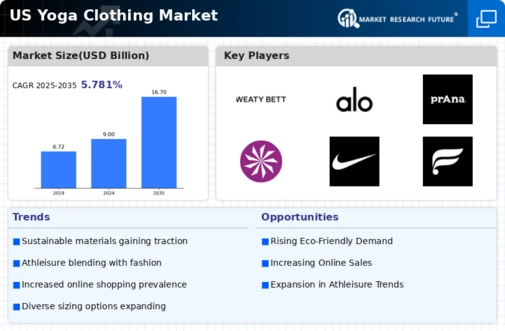Influence of Social Media
Social media platforms have emerged as powerful tools for promoting the yoga clothing market. Influencers and fitness enthusiasts frequently showcase their yoga practices and associated apparel, creating a visual culture that encourages followers to invest in similar products. This phenomenon has led to increased brand visibility and consumer engagement. The yoga clothing market is likely to see a continued rise in sales as brands leverage social media marketing strategies to reach younger demographics. With over 70% of consumers reporting that social media influences their purchasing decisions, the impact of these platforms cannot be underestimated.
Rise of Athleisure Culture
The rise of the athleisure culture has significantly impacted the yoga clothing market. Consumers increasingly prefer versatile clothing that can transition from workout sessions to casual outings. This trend has led to a broader acceptance of yoga apparel as everyday wear, thus expanding the target demographic. The yoga clothing market is witnessing a notable increase in sales, with estimates suggesting that athleisure could account for over 30% of the total apparel market by 2026. This shift indicates a growing consumer preference for comfort and style, driving brands to innovate and diversify their offerings.
Environmental Consciousness
Growing environmental consciousness among consumers is driving demand for sustainable practices within the yoga clothing market. As individuals become more aware of the ecological impact of their purchases, they are increasingly seeking brands that prioritize sustainability. This shift has prompted many companies to adopt eco-friendly materials and ethical manufacturing processes. The yoga clothing market is responding to this demand, with a significant portion of consumers willing to pay a premium for sustainable products. Reports indicate that approximately 50% of consumers are more likely to choose brands that demonstrate a commitment to environmental responsibility.
Health and Wellness Awareness
The increasing awareness of health and wellness among consumers appears to be a primary driver for the yoga clothing market. As individuals prioritize physical fitness and mental well-being, the demand for yoga apparel has surged. According to recent data, the market is projected to grow at a CAGR of approximately 8% over the next five years. This trend indicates that consumers are not only participating in yoga but are also investing in high-quality clothing that enhances their practice. The yoga clothing market is benefiting from this shift, as more people seek comfortable, functional, and stylish options that align with their health-focused lifestyles.
Diversity in Marketing Strategies
The yoga clothing market is experiencing a shift towards more diverse marketing strategies that resonate with a broader audience. Brands are increasingly recognizing the importance of inclusivity and representation in their advertising campaigns. This approach not only attracts a wider customer base but also fosters brand loyalty among consumers who feel represented. The yoga clothing market is likely to benefit from this trend, as companies that embrace diversity in their marketing efforts may see an increase in sales. Research suggests that brands with inclusive marketing strategies can experience up to a 20% boost in customer engagement.

























Leave a Comment